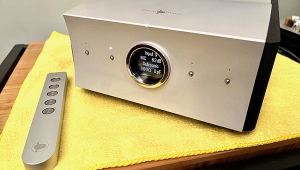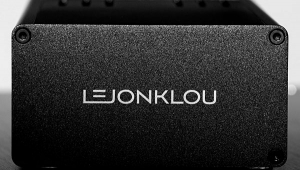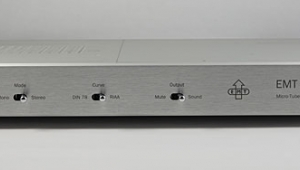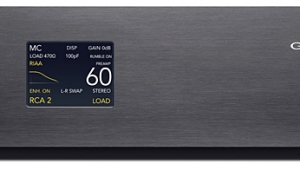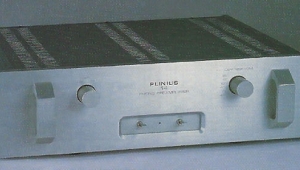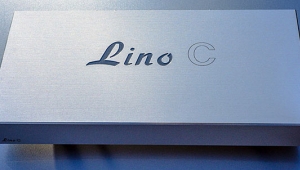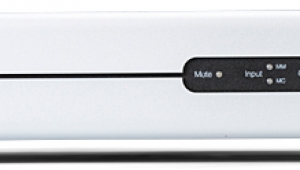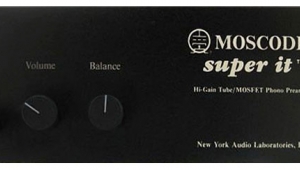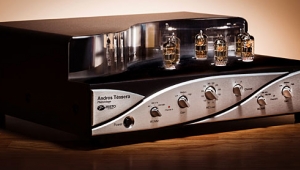| Columns Retired Columns & Blogs |
Nagra BPS phono preamplifier
This tiny, lightweight, battery-powered jewel is loosely based on Nagra's VPS phono stage that I reviewed in October 2008 but uses bipolar transistors instead of tubes. The bottom of the company's familiar brushed-aluminum case has a grippy rubber material die-cut to spell Nagra. It's intended to keep the preamp from sliding, but stiff cables will have the BPS hanging in the air if you're not careful. The BPS costs $2399.

The BPS provides a highish 51dB gain in moving-magnet mode and 62dB in moving-coil, which should suffice for all phono cartridges, other than those of the very lowest output. The MC circuit uses the same excellent custom-wound transformers found in the more expensive VPS. The BPS doesn't consume much power—its single 9V battery should provide about 100 hours of use before it needs replacing. The On/Off switch includes a battery-test position, but unfortunately my pea brain had me forgetting to turn the BPS off many times—I went through quite a few batteries. The BPS also has a jack for a power adapter—not for listening, but to keep the circuit "busy" and warmed up when you're not listening.
Internal jumpers let you set MM or MC, and balanced or unbalanced operation. The BPS comes from the factory already set for unbalanced operation, which Nagra suggests you leave unchanged unless you encounter hum. The MM default setting is 47k ohms loading at 150pF capacitance. Supplied plug-in modules let you switch between capacitive and resistive loading, depending on whether your cartridge is MM or MC. The resistive loading modules are 100, 200, 300, 500, and 1000 ohms.
When, 20 years ago, I interviewed the great recording engineer/producer Roy Halee at his home, he pointed to his Wilson WATT/Puppy 1 speakers, his Mark Levinson electronics and digital playback gear, and said, "This is what I listen to when I want to hear what's on a recording I've made, and this"—pointing to his Infinity IRS towers, Jadis electronics, and turntable—"is what I listen to when I want to enjoy music."
That's not quite how I felt about the two Nagra phono preamps. The BPS was a more neutral, accurate phono preamp than the lush, romantic VPS. The VPS is wonderful to listen to most kinds of music with, but it's hardly tonally accurate. The BPS was far more so, particularly in the bottom octaves, but it was also a wonderful component to listen to music through. It produced sharp, clean, exciting transients that made the Benz-Micro ACE SL sit up and sing, but it also complemented the Transfiguration Phoenix, and every other cartridge I tried with it. Still, I preferred the more analytical models, loaded down to 300 ohms or lower.
The BPS was as lean and clean as the VPS is lush and romantic. The two models are sonic opposites. While the BPS omits the VPS's overabundant, romantic, somewhat ripe bottom end, there was one interesting carryover: like that of the VPS, the BPS's bass had "stickion." It gripped and held on for a fraction of a second longer than I expected, but its leaner bass was better integrated into the overall sound.
At Amoeba Music in Hollywood last year, I lucked into a mint-condition original UK pressing of John Renbourn's 1969 solo album, Sir John Alot of Merrie Englandes Musyk Thyng & ye Grene Knyghte (Transatlantic), which I highly recommend if you like acoustic folk guitar. (Just stay away from the Lost Lakes/Windham Hill reissue of the mid-1980s, which was cut from digital and sucks as badly as the original is amazingly great.) The BPS's fast, clean, tight rendering of this record was among the best I've heard. That said, the BPS definitely went for attack at the expense of sustain. It was all about rhythm and pace and less about harmonic structure and richness, though the latter, too, were in good supply.
The BPS sacrificed a bit of the Renbourn album's ambience and some drum skin, but the flute and Renbourn's acoustic guitar were amazingly clean and precise without sounding hard and/or bright—and I've been playing my original pressing of this album since 1969. That copy is a bit noisy and worn, thanks mostly to being stacked on a Dual 1019.
(Yes, stacking. I was young and foolish. Sometimes the static charge on the yet-to-drop stack was so great it would lift the tonearm from the record being played and leave it hanging in mid-air. But did I get the message? Noooooo . . . )
Depending on your system and cartridge, you'll find the Nagra BPS exciting, dynamic, transparent, and ultraclean—or relentless, dry, tight, and fatiguing. But it was so clean on top that I don't think you'll find it bright, nor will it add any unwanted hardness or grain. It stepped out to the edge but didn't fall off. However, the rest of your system might just push it over that edge.
I had the BPS here for a few months and used it with a wide variety of cartridges. It let all their personalities through while contributing little of its own, save for its upfront transient speed, clarity, and focus. If your system needs an injection of excitement, the BPS is guaranteed to do just that. In fact, there's a lot to be said for owning a phono preamplifier as fast, revealing, and honest as this: transducers are where the serious colorations reside. You're better off with a phono preamp like the BPS; then, you can reliably add the colors you prefer with your choice of cartridge, MM or MC.
If you're lucky enough to have a Nagra dealer nearby, arrange to take one of these little guys home and give it a try. You can easily sneak it past your wife tucked in a pocket! Just be sure to experiment with loading, even if you're a confirmed 47k ohms guy. There's a good chance you won't return it.—Michael Fremer
Michael Fremer returned to the BPS in August 2009 (Vol.32 No.8):
The review sample of the Audio Research PH7 came well broken-in, with hundreds of hours of play already logged. Still, I found it best to give the PH7 an hour's warmup before doing any serious listening. I had a yin/yang thing going, with the PH7 and Nagra's diminutive BPS that I reviewed in June ($2399), with both hooked up. The two phono preamps could not have been more different, though they shared one positive attribute: both were relatively quiet. The PH7 produced little in the way of "tube rush," thanks to its JFET front end, yet it sounded about as "tubey" as a good tubed phono preamp can, with maximum musical flow and no hint of etch or grain. The Nagra was lean, fast, tight, and clean. The PH7 was richer, warmer, more delicate, more harmonically complex, and more revealing of instrumental textures and nuances. If you crave more of those attributes, the PH7 delivered them on a platter.
Some astute visitors to my listening room were relieved when I switched from the warm clutches of the ARC PH7 to the Nagra BPS's effervescent speed and transient cleanness—but within minutes they were missing the PH7's harmonic richness and complexity, and its generously deep and wide soundstaging. "There was something happening there," said one, pointing to the PH7, "that's not happening there," pointing to the BPS. Ten minutes later, he was yearning for the BPS's crisp attack.
And so it went, all evening.—Michael Fremer
- Log in or register to post comments
